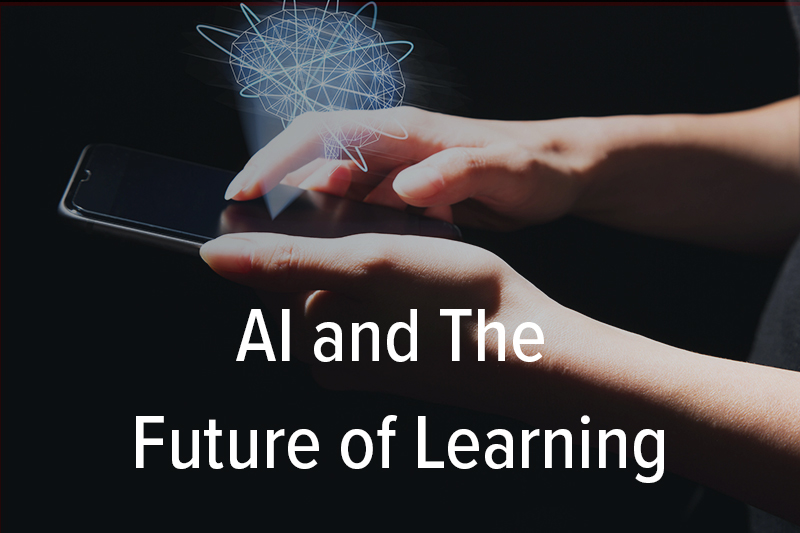

Nick Hjort
SVP of Product and Development
For many people the term Artificial Intelligence (AI) conjures frightening visions of systems like Skynet from Terminator or HAL from 2001, which may lead to a valid level of apprehension of any technology that claims to employ AI. This fear may increase when AI is applied to something as personal as learning. In fact, great minds like Elon Musk and Stephen Hawking have warned us against the potential dangers of Artificial Intelligence.
The truth is that great benefit can be found in online learning with the lightest application of Artificial Intelligence. Merriam Webster defines Artificial Intelligence as “a branch of computer science dealing with the simulation of intelligent behavior in computers.” Intelligent behavior can manifest itself in computers in many ways from the overt to the subtle, while still not getting close to the dystopian image of AI from the movies.
When done properly, the utilization of AI can be applied without distracting from the learning experience itself. By creating a sophisticated algorithm, AI can create learning environments that improve learner insights and experience.
Here are just a few ways that you may see AI applied within online learning experiences. They range from the obvious to the behind the scenes application of Artificial Intelligence within learning software.
Personalized Learning
Developing a personalized learning path or a tutor-like experience increases engagement as it makes the experience meaningful. Creating platforms that adjust to only deliver content that learners are not knowledgeable about improves engagement and desirability while also providing instructors with valuable insights. These small nudges and personalizations simulate interpersonal experiences, but cost less and provide ample insight into knowledge gaps.
These personalized learning paths manifest in 2 different ways:
One way is through assignment generation from one learning experience to another. The AI system will make a determination from the results of one learning experience to determine what the learner should do next. Whether that is more exposure to a particular topic because the results show the learner didn’t grasp that topic well enough, or if it’s new material to advance what has already been learned because proficiency in the base topic was shown by the learner.
The other way is personalizing the learning experience while it is happening. An AI system can determine how well a learner is grasping concepts and adjust in real time to what a learner needs. Strategies like branching, skipping topics where mastery is shown early, repeating of topics in other forms where struggle is present, are just a couple of the methods to achieve this personalization. Advantages of personalizing the learning experience are: Time savings for learners who show mastery early, or have a large amount of initial knowledge on the topic. Assurance that mastery has been achieved instead of just time spent by the time learning experience is completed.
Behavior Assistance
Behavior Assistance is a powerful AI tool that can improve attention and offer encouragement or guidance. AI assistance tracks when learners are disengaged, trying to cheat, or kicking ass. When disengaged behavior is detected, AI can step in and change those behaviors. We know that focus and motivation are key behaviors that lead to lasting learning, so the AI will encourage or correct disengaged behavior so that a learner can maximize the benefit from their time spent learning.
An AI nudge could be the difference needed to get learners to realize that the eLearning is just as real and valuable as a face-to-face discussion or performance evaluation. The valuable insight Behavior Assistance provides to the designers and instructors informs them if their performance results are aligning with the behavior. Behavior Assistance indicates if the learning is going to lead to change. It could be the insight that determines if a learner is apathetic or genuinely trying, but really struggling or if they are taking learning seriously and succeeding. This gives trainers and instructors the information to better facilitate targeted interventions and conversations to further improve upon the learner’s knowledge gains and resulting performance.
During the learning experience, behavior assistance can manifest in either a passive or active manor. Passive assistance takes the form of learner messaging that nudges them into the correct behavior. Passive assistance may also go as far as to inform an instructor of the behavior of the learner so that a needed intervention may occur. Active assistance takes more of a commanding role of the experience. The AI may actively force a learner to do more work or repeat a topic when poor behavior is detected. Other actions may be taken such as a forced break from the software to try to get the learner in the correct mindset for learning.
Instructor Assistance
Perhaps one of the most valuable tools AI can provide to improve learning outcomes and truly shape the future of learning is through the reporting. A learner’s behavior and performance can be shown through reports indicating where interventions are needed or even where a shift in our own instruction should occur. A well-written AI can pinpoint where an individual or group; struggles, has uncertainty, where they hold incorrect prior knowledge, or holds dangerous information. From these reports, personalized learning through the platform is provided and instructors can also align their own instruction and coaching to specifically meet the needs of their learners.
The aim for AI in learning should not be to replace an instructor or manager in the overall learning experience. AI should be the first line of analysis to try to assess what is going on with a learner. This will aid an instructor in pinpointing where there time is best spent with a specific learner or in front of an entire class. As with most software, the goal is to optimize time to be sure that the highest level of value is gained from the time spent on a task.
ChatBot
ChatBot is a feature that many learning platforms employ to generate a more interpersonal experience and give learners more autonomy to freely ask questions. In many instances, learners will be more open with a Chatbot than they would in a face-to-face environment because any social hindrances are completely removed. ChatBots can lead to a distracted or frustrated learning experience if not created thoughtfully. Learners can tell when answers are automated and become frustrated if the ChatBot does not deliver satisfactory answers to their questions.
Conclusion
AI is incredibly powerful. It can save organizations the laborious task of analyzing curriculum or results just to determine what’s working and what is not. AI can also save organizations time by automating tedious tasks. Through personalized and data-driven eLearning, less time is needed to cover curriculum thus, organizations can spend their time delivering more individualized and meaningful approaches to training than before. AI is powerful, but only works really well when we keep humanity involved.
Remember, AI is best employed when it is not noticed. It should not be a distraction to learning; rather it should be a natural enhancement to a learning product that improves outcomes and experiences. Behind every insight, every interaction or algorithm created, people are there. AI can make life easier, so more time can be spent building meaningful and productive relationships that evoke greater results.







